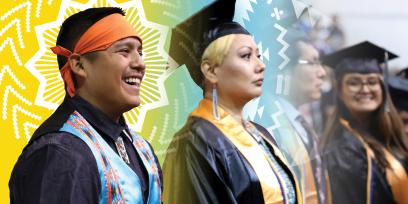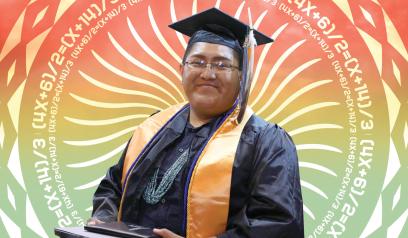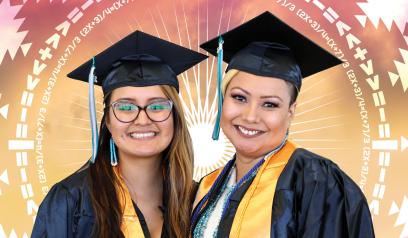Community colleges have long provided students a gateway to greater economic opportunities, primarily through two pathways: completing two years of college courses while preparing to transfer to earn a four-year degree or career training that can lead to stable, well-paying positions. The community college where I teach offers something more: a much-needed affirmation of Native American students’ histories, values, identities, and cultures.
I teach math to students at Southwestern Indian Polytechnic Institute (SIPI) in Albuquerque, New Mexico. When it comes to issues of culture, math as a discipline mostly goes unnoticed. Given that subjects in the humanities and social sciences more easily lend themselves to students’ lived experiences, classes about equations and functions hardly seem to connect to values and identities. But at SIPI, we show students that these connections do in fact exist, and we ensure that they play a central role in Native students’ education. In teaching math and other subject matter content, we intentionally build on our students’ cultural knowledge because research shows that doing so is invaluable to their academic, social, and emotional development.* By incorporating students’ backgrounds into the classroom, we as educators help them learn more effectively.
One of 37 tribal colleges and universities in the United States, SIPI is a community college funded through the Bureau of Indian Education. All of the approximately 460 students enrolled† in the college are Native American. They come from 18 states and represent 71 different tribes.
SIPI not only respects Native students’ cultural backgrounds and traditions but also intentionally supports tribal nation-building through its array of two-year degree and certificate programs. SIPI collaborates with tribes to understand their education and workforce needs—which in recent years have centered on healthy food, clean and sufficient water, sustainable energy, and accessible and equitable healthcare—and then responds with tailor-made degrees and certificates in fields such as culinary arts, environmental science, natural resources management, and vision care. At the same time, SIPI provides degrees and certificates in fields that meet universal needs and offer broad opportunities, such as accounting, early childhood education, and computer-aided drafting and design, to name just a few.
Because mathematics is a required course for every program, I have students from a range of disciplines, and I teach the full gamut of math courses—from pre-algebra to calculus. Classes are typically small, with only 10 to 15 students, so I get to know my students quite well. Many work full- or part-time jobs, and some are raising children or caring for family members while they attend school.
Nearly 70 percent of students at SIPI test into developmental math courses, which consist of pre-algebra and algebra.‡ These courses, for which students don’t receive college credit, are ones they must take in order to enroll in credit-bearing math courses required for a degree. I find teaching these courses—and building relationships with my students through them—especially rewarding.
Confronting Bias
I wanted to teach at SIPI because it’s specifically for Native students. Such students are typically not well represented in higher education—as students or professors. As a Black woman from Puerto Rico, I myself did not see many people who looked like me in my undergraduate and graduate programs, not only because of my race and ethnicity but also because of my gender. I often tell my students about the time 20 years ago when one of my college math professors in Puerto Rico looked right at me and said in front of the entire class that women should not be studying math. His words stung. Because I was so intimidated by this professor, I considered dropping the class, but I decided to stay; I needed to prove him wrong. I paid careful attention in class, completed all the assignments, and studied hard for tests—and I passed the course. While proving him wrong, I also learned a lot about what being a professor could and should mean. Less than 20 percent of the students passed the class, which I think says more about that professor than it does about the students. We all had potential, but we had to look outside the class for support. I was a determined student, but I was also fortunate to find the help that my professor was not offering.
To this day, people still assume I don’t have much education just because of the way I look. Whether it’s due to implicit biases or systemic racism or a combination of both, they are surprised to learn I have a PhD in math education. I make it a point to share my story with my students so they know they can succeed even if others doubt their abilities.
Part of the key to being successful is having somebody who believes in you. One of my students last year was a 27-year-old transfer student who thought he couldn’t do math. He really struggled with the material, and after every class he would tell me he just couldn’t learn the content. But I started tutoring him after class and kept encouraging him to stick with it, and he started earning good grades. I remember the time he was so proud of his A on a test. He told me he couldn’t wait to go home and show it to his mother so she could put it on the refrigerator door. He’s no longer my student, but we keep in touch; he often texts me updates on his life. Sometimes I still tutor him when he’s stuck on a particular concept.
Part of my job—and also my passion for teaching—is tutoring students. At SIPI, faculty members are required to spend a few hours each week tutoring students during their office hours or in the STEM (Science, Technology, Engineering, and Math) Lab and Writing Lab on campus. In my role as a math professor, I am the students’ main contact for the STEM Lab, where I tutor about four hours each week. In March 2020, because of the pandemic, we moved all classes and tutoring sessions at SIPI to synchronous meetings online. So now I tutor my students through Zoom. I try to be available at times that work for them, including nights and weekends, since many of them work full time.§
Engaging Students in the Content and Their Cultures
A couple of years ago, to better support students, our department decided to modularize beginning algebra. “Modularization” is a term for breaking up a semester-long course into smaller parts so that students have more time to grasp key concepts and master skills. If students fail a module, they can repeat it (without failing the course) before moving on to the next module. We also modularized intermediate math, the course that follows beginning algebra. Although the research on modularization has shown mixed results,** it is helping our students make progress. Passing rates in beginning algebra have increased from 47 percent to 57 percent and in intermediate algebra from 44 percent to 49 percent. We’ve also noticed that because students are not nearly as stressed about their grades, they can focus more on understanding the content. The emphasis on tutoring and the availability and approachability of faculty members has also helped students in these courses.
As a professor, I like the modular approach because it gives me more time to teach the material over the course of the year. I don’t have to rush to cover a particular concept, and I can incorporate more projects and group work to help students grasp the content.
At a tribal college, such projects are especially important. I see them as a way to bring students’ cultures, languages, and experiences into our math classes and show students how math relates to their daily lives. For example, in a recent class on math for prospective elementary school teachers, as we were studying patterns and problem solving, one of my students talked about quilting in her Native culture. So we incorporated the art of quilting into our patterns and problem-solving unit. Another student in the class compared the beadwork that her family does, with its specific patterns and colors, to the math we were studying. And she then turned in a marvelous project on beading. In another class, I was teaching about percentages and students related it to their blood quantum,†† the degree to which a person can prove a certain amount of Native ancestry. They started talking excitedly about what blood quantum their children would have if they married people from various tribes. While my students usually shy away from doing fractions because they find them challenging, they eagerly made these calculations because the mathematical concepts suddenly became real for them.
Making such connections to our students’ lives happens throughout the college. In English courses, many assigned readings are by Native authors and relate to Native cultures. Culinary classes often feature projects in which students incorporate their cultures into dishes to give them a Native flair. (I’m not sure which ingredients they use, but I’ve tasted many of their meals, and they are delicious!) In environmental science courses, students learn about Native plants and Native botanists. In pre-engineering classes, students learn how to program robots to respond to Diné, the Navajo language. It’s a language students can also learn at SIPI, which offers this language class since more than 60 percent of students are Navajo.
Since many of our students enjoy strong bonds with their tribes, they often attend ceremonies for holidays at home. The college calendar does not always line up with the various holidays students from different tribes celebrate, so sometimes students miss school. While they still must complete their course work, we definitely make space for them to engage in their cultural practices. At SIPI, we explicitly let students know just how much we respect their heritage.
It’s a heritage that I’m continuing to learn more about. Growing up in Puerto Rico, the history books we read in school only superficially explained how Puerto Ricans are descended from Spaniards, Africans, and Taínos, the Indigenous people of the Caribbean. But we didn’t really study Indigenous people in school, and I have no real knowledge of the Taíno or their culture, though I’m interested in building it. Attending a SIPI colleague’s feast was my first real exposure to Native celebrations, and I’m eager to attend more.
Bolstering Student Success
Modularization is not the only way SIPI tries to support students’ academic success. Many students take advantage of services, besides tutoring, offered on campus at the STEM Lab and the Writing Lab. The STEM Lab offers plenty of resources, such as a group collaboration area, a semi-private computer area with whiteboards, calculators, graphing paper, and workstation equipment with paper cutters, staplers, and hole punches. To further support students in developmental math courses, we ask that they sign math contracts. By signing such contracts, students commit to two hours of mandatory tutoring each week outside of class. Students can sign up for this tutoring at the STEM Lab or the coaching center on campus, which offers peer tutoring.
A popular childcare option for students with young children is an early childhood center on campus. Students can enroll their children in the center (as space allows) while they take their classes. Under the supervision of faculty members, students studying to be early childhood teachers work with the children of SIPI students and gain actual student-teaching experience.
One effort that is especially close to my heart is the Summer Bridge‡‡ program that I direct at the college. It’s specifically geared for students who need support in reading, math, and study skills, and as a result, may not be college ready. I started the program in 2018 to help students successfully transition to college. We actually run two separate programs—a residential program for traditional-age students (typically 18 to 20) who live on campus and a nonresidential one for older students who live off campus. At SIPI during the school year, the majority of students live in dorms on campus, while the rest commute from Albuquerque and the surrounding suburbs.
We started Summer Bridge because we found that student attrition was highest in the first trimester. By helping students build their knowledge and skills before the academic year begins, we can increase the number of students who persist in college and eventually earn their degree. Throughout both the residential and nonresidential programs, faculty members support students in English and math, share study tips and information about college life, and engage students in community-building activities. The program is free for students and funded through a mix of government funding and grants. It’s worth noting that students are not required to enroll in SIPI after Summer Bridge. The whole point of the program is to ensure they have a successful transition to higher education no matter where they attend.
Results so far have been promising.§§ In 2019, the residential program enrolled 30 students and ran for five weeks with classes held during the day. Of those students, 77 percent matriculated at SIPI. The nonresidential program enrolled 11 students and ran for eight weeks with classes in the evenings to accommodate students’ work schedules. Of those students, 91 percent matriculated at SIPI. Because of the suite of supports for students who are not yet college ready, the percentage of students earning credit hours in their first trimester has increased from 74 to 83, while their first-term grade point average has increased from 1.81 to 2.15. Overall, the passing rate in courses has increased from 53 to 64 percent.
While students attend SIPI, we make every effort to prepare them for enrolling in a four-year college or entering the workplace. Guidance counselors help students with their transcripts and resumes. The campus holds career fairs every trimester, and a staff member works with students to land internships. Of the students who decide to pursue university studies, many attend the University of New Mexico (UNM), New Mexico State University, and New Mexico Highlands University. One of my former students is now studying math at UNM, and another is pursuing a major in Native American studies at Arizona State University.
Wherever my students end up, I want them to understand and appreciate math as it relates to their lives, and I want them to believe in themselves. I still keep in touch with another student from 2019 who almost withdrew from one of my classes the first week of the trimester. At the time, he was 30 years old. He confided in me that he had never been good at math, and he said a professor at another college even told him as much. So I asked him, “Do you believe him?” When he said yes, I knew I had to help change his mindset.
I convinced him to stay in the class, and I worked with him to ensure he understood the material. At the end of the trimester, he ended up with the highest grade in the class. He is hands down one of the best students I have ever had. When he recently asked me if I thought he could be a math tutor at SIPI, I told him, “Of course you can.” My job isn’t just to teach students math—it’s to help them see themselves as individuals who, once they make the effort, can succeed at math and anything they do.
Eva L. Rivera Lebrón is a professor of mathematics at Southwestern Indian Polytechnic Institute in Albuquerque, New Mexico. She has given several presentations on supporting community college students’ transition into and success in developmental and credit-bearing mathematics courses at conferences held by the National Indian Education Association.
* For more on why it’s important to build on students’ cultures, see How People Learn II: Learners, Contexts, and Cultures. (return to article)
† I am offering an approximation because enrollment fluctuates each trimester. (return to article)
‡ For more on supporting students in such courses, see the article, “In College, But Not Always Earning College Credit.” (return to article)
§ Although supporting students in and out of class is core to who I am as a professor and I am deeply nourished by my work, I recognize that in many higher education institutions there are professors who become stretched too thin as they strive—too often alone—to meet students’ needs. For a thought-provoking article that explores “diversity service work,” see “How Diversity Rhetoric Obscures Structural Inequities in Higher Education.” (return to article)
** For more on the research behind modularization, see Modularization in Developmental Mathematics in Two States, “Modularization—a Road to Relevance?”, and Effects of Modularisation. (return to article)
†† For a fuller discussion of blood quantum, see “So What Exactly Is ‘Blood Quantum’?” (return to article)
‡‡ For more on the Summer Bridge program, see here. (return to article)
§§ Because of the pandemic, we did not hold the Summer Bridge program this past summer; for months, the campus has been closed to ensure student and staff safety, and all classes are now synchronous meetings online. I’m currently working on making Summer Bridge a virtual program that can be held at any time during the year. (return to article)
[illustrated by Tommy Greyeyes, photos of students courtesy of Southwestern Indian Polytechnic Institute]




